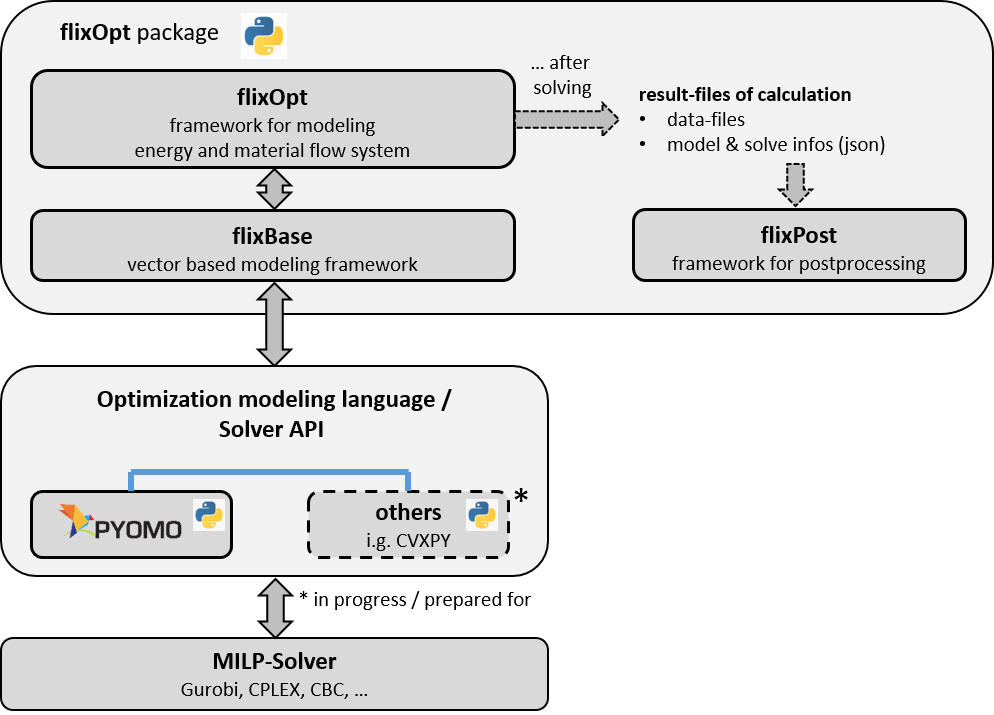FlixOpt
🎯 Vision
FlixOpt aims to be the most accessible and flexible Python framework for energy and material flow optimization.
We believe that optimization modeling should be approachable for beginners yet powerful for experts. Too often, frameworks force you to choose between ease of use and flexibility. FlixOpt refuses this compromise.
Where We're Going
Short-term goals:
- Multi-dimensional modeling: Multi-period investments and scenario-based stochastic optimization are available (periods and scenarios are in active development for enhanced features)
- Enhanced component library: More pre-built, domain-specific components (sector coupling, hydrogen systems, thermal networks, demand-side management)
Medium-term vision:
- Modeling to generate alternatives (MGA): Built-in support for exploring near-optimal solution spaces to produce more robust, diverse solutions under uncertainty
- Interactive tutorials: Browser-based, reactive tutorials for learning FlixOpt without local installation (marimo)
- Standardized cost calculations: Align with industry standards (VDI 2067) for CAPEX/OPEX calculations
- Advanced result analysis: Time-series aggregation, automated reporting, and rich visualization options
- Recipe collection: Community-driven library of common modeling patterns, data manipulation techniques, and optimization strategies (see Recipes - help wanted!)
Long-term vision:
- Showcase universal applicability: FlixOpt already handles any flow-based system (supply chains, water networks, production planning, chemical processes) - we need more examples and domain-specific component libraries to demonstrate this
- Seamless integration: First-class support for coupling with simulation tools, databases, existing energy system models, and GIS data
- Robust optimization: Built-in uncertainty quantification and stochastic programming capabilities
- Community ecosystem: Rich library of user-contributed components, examples, and domain-specific extensions
- Model validation tools: Automated checks for physical plausibility, data consistency, and common modeling errors
Why FlixOpt Exists
FlixOpt is a general-purpose framework for modeling any system involving flows and conversions - energy, materials, fluids, goods, or data. While energy systems are our primary focus, the same mathematical foundation applies to supply chains, water networks, production lines, and more.
We bridge the gap between high-level strategic models (like FINE) for long-term planning and low-level dispatch tools for operations. FlixOpt is the sweet spot for:
- Researchers who need to prototype quickly but may require deep customization later
- Engineers who want reliable, tested components without black-box abstractions
- Students learning optimization who benefit from clear, Pythonic interfaces
- Practitioners who need to move from model to production-ready results
- Domain experts from any field where things flow, transform, and need optimizing
Built on modern foundations (linopy and xarray), FlixOpt delivers both performance and transparency. You can inspect everything, extend anything, and trust that your model does exactly what you designed.
Originally developed at TU Dresden for the SMARTBIOGRID project (funded by the German Federal Ministry for Economic Affairs and Energy, FKZ: 03KB159B), FlixOpt has evolved from the Matlab-based flixOptMat framework while incorporating the best ideas from oemof/solph.
What Makes FlixOpt Different
Start Simple, Scale Complex
Define a working model in minutes with high-level components, then drill down to fine-grained control when needed. No rewriting, no framework switching.
import flixopt as fx
# Simple start
boiler = fx.Boiler("Boiler", eta=0.9, ...)
# Advanced control when needed - extend with native linopy
boiler.model.add_constraints(custom_constraint, name="my_constraint")
Multi-Criteria Optimization Done Right
Model costs, emissions, resource use, and any custom metric simultaneously as Effects. Optimize any single Effect, use weighted combinations, or apply ε-constraints:
costs = fx.Effect('costs', '€', 'Total costs',
share_from_temporal={'CO2': 180}) # 180 €/tCO2
co2 = fx.Effect('CO2', 'kg', 'Emissions', maximum_periodic=50000)
Performance at Any Scale
Choose the right calculation mode for your problem:
- Full - Maximum accuracy for smaller problems
- Segmented - Rolling horizon for large time series
- Aggregated - Typical periods using TSAM for massive models
Built for Reproducibility
Every result file is self-contained with complete model information. Load it months later and know exactly what you optimized. Export to NetCDF, share with colleagues, archive for compliance.

Installation
For more detailed installation options, see the Getting Started guide.
License
FlixOpt is released under the MIT License. See LICENSE for details.
Citation
If you use FlixOpt in your research or project, please cite:
- Main Citation: DOI:10.18086/eurosun.2022.04.07
- Short Overview: DOI:10.13140/RG.2.2.14948.24969
A more sophisticated paper is in progress